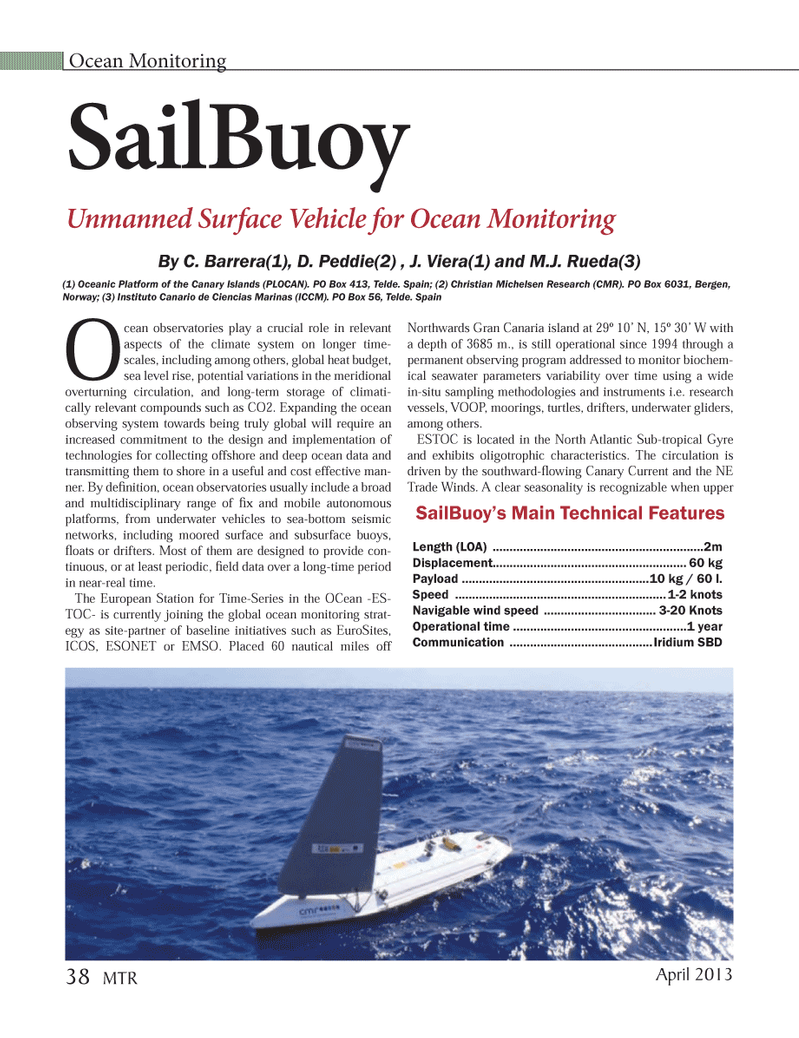
Page 38: of Marine Technology Magazine (April 2013)
Offshore Energy Report
Read this page in Pdf, Flash or Html5 edition of April 2013 Marine Technology Magazine
Ocean observatories play a crucial role in relevant aspects of the climate system on longer time-scales, including among others, global heat budget, sea level rise, potential variations in the meridional overturning circulation, and long-term storage of climati- cally relevant compounds such as CO2. Expanding the ocean observing system towards being truly global will require an increased commitment to the design and implementation of technologies for collecting offshore and deep ocean data and transmitting them to shore in a useful and cost effective man- ner. By deÞ nition, ocean observatories usually include a broad and multidisciplinary range of Þ x and mobile autonomous platforms, from underwater vehicles to sea-bottom seismic networks, including moored surface and subsurface buoys, ß oats or drifters. Most of them are designed to provide con- tinuous, or at least periodic, Þ eld data over a long-time period in near-real time. The European Station for Time-Series in the OCean -ES- TOC- is currently joining the global ocean monitoring strat- egy as site-partner of baseline initiatives such as EuroSites, ICOS, ESONET or EMSO. Placed 60 nautical miles off Northwards Gran Canaria island at 29¼ 10Õ N, 15¼ 30Õ W with a depth of 3685 m., is still operational since 1994 through a permanent observing program addressed to monitor biochem-ical seawater parameters variability over time using a wide in-situ sampling methodologies and instruments i.e. research vessels, VOOP, moorings, turtles, drifters, underwater gliders, among others.ESTOC is located in the North Atlantic Sub-tropical Gyre and exhibits oligotrophic characteristics. The circulation is driven by the southward-ß owing Canary Current and the NE Trade Winds. A clear seasonality is recognizable when upper Ocean Monitoring SailBuoy Unmanned Surface Vehicle for Ocean Monitoring By C. Barrera(1), D. Peddie(2) , J. Viera(1) and M.J. Rueda(3) (1) Oceanic Platform of the Canary Islands (PLOCAN). PO Box 413, Telde. Spain; (2) Christian Michelsen Research (CMR). PO Box 6 031, Bergen, Norway; (3) Instituto Canario de Ciencias Marinas (ICCM). PO Box 56, Telde. Spain SailBuoy?s Main Technical Features Length (LOA) ..............................................................2m Displacement.........................................................60 kg Payload .......................................................10 kg / 60 l. Speed ..............................................................1-2 knots Navigable wind speed .................................3-20 Knots Operational time ...................................................1 year Communication ..........................................Iridium SBD April 201338 MTRMTR #3 (34-49).indd 38MTR #3 (34-49).indd 384/4/2013 9:22:02 AM4/4/2013 9:22:02 AM

 37
37

 39
39
